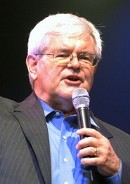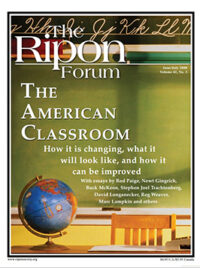
I was proud to help create the Hart-Rudman Commission on National Security and later serve on it once I stepped down as Speaker. Our report, released in early 2001, stated that the greatest threat to America’s national security was a weapon of mass destruction going off in an American city, most likely from terrorists.
Very few paid attention to the findings, but that changed a few months later when the terrorist attacks of September 11, 2001 showed just how vulnerable we are. Spurred by the attacks, the United States has made significant investments to address this threat, many of which were adopted from the recommendations found in the report. There is no doubt that the issue of our security will be a significant part of our political debate for years to come.
Tragically, the same cannot be said for what the report found to be the second greatest threat to America’s national security — the failure of America’s math and science education system. Little focus has been paid to just how dangerous it is to allow other countries, especially non-democracies, to become the high-tech centers of the world.
This is especially dangerous because Hart-Rudman was hardly the first report to warn us of the threat posed by the failure of our education system. “A Nation at Risk” released in 1983 said, “If an unfriendly foreign power had attempted to impose on America the mediocre educational performance that exists today, we might well have viewed it as an act of war. As it stands, we have allowed this to happen to ourselves.” Little more than marginal change has been enacted since these reports were issued, and it is unlikely there will ever be a September 11th type of wake-up-call in the realm of math and science education that will motivate us towards dramatic action.
The result of our inaction is obvious. The United States continually ranks near the bottom in OECD rankings of student mathematical achievement. The National Science Foundation found that in 2005 only 35% of U.S. eighth graders were deemed to be proficient in math. China and India graduate five times as many engineers as the United States.
…as we look for solutions to rapidly improve math and science education in the United States it is important that we distinguish between merely investing more in our current education bureaucracies and actually investing in math and science education.
There are those who will argue that the solution is more money for our schools. The facts show that money alone is not the answer. When President Reagan received the “A Nation at Risk” report in 1983, the United States was in the midst of a massive increase in education spending. Per pupil expenditures in constant dollars had increased from $4,060 dollars in 1970 to almost $6,000. “A Nation at Risk” showed that regardless of this nearly 50% increase in spending there was little progress to report. Despite President Reagan’s warning, national education spending per pupil in constant dollars has increased again by approximately 50% since 1983, with 2005 spending at $9,266. Meanwhile, test results have continued to flat-line.
So, as we look for solutions to rapidly improve math and science education in the United States, it is important that we distinguish between merely investing more in our current education bureaucracies and actually investing in math and science education. The former would simply be doing more of what we are already doing and expecting a different result. Albert Einstein defined this as the definition of insanity. The latter will require bold leadership to force through needed changes in the current system and to develop new systems of learning that are very different than what we are used to and totally outside the current education system.
School choice must be included in our set of solutions. In addition to the urgent national security need for improving our educational system, there is also the moral imperative of liberating students in poor neighborhoods from an environment that will cripple their lives. School choice will provide immediate relief to those trapped in failing schools. Furthermore, introducing market forces to our education system by forcing schools to compete for students will inspire improvement faster than the slow, cumbersome movement of the education bureaucracy.
We should also experiment with offering direct incentives to students to accelerate their pace of learning beyond what is expected of them by school curricula. Imagine if students who finish high school early were given the cost of their remaining years in the form of scholarships. This would cost the taxpayers nothing and motivate students – especially those in poorer neighborhoods – to learn as rapidly as possible.
A more radical idea is to pay students directly for getting a B or better in their math and science classes. The idea offends many who either believe learning should be its own reward or don’t think we should place special value on math and science over the arts, humanities, and social sciences. However, if we are serious that the failure of our math and science education is the second greatest threat to America’s national security, there is nothing wrong with providing extra motivation for students to succeed in areas where we have the most urgent need. Money is a powerful motivator in every other area of American life. Why should education be any different?
Of course, an essential part of allowing students to learn on their own, independent of the set patch of the school curriculum is developing a clearinghouse of knowledge that is accessible to everyone for free. The federal government can play a role by contributing to the Library of Congress online learning programs that teach basic math through trigonometry and calculus as well as the physical sciences.
This initiative would be especially powerful combined with initiatives like Nicolas Negroponte’s One Laptop per Child, which has produced a durable, $189 laptop specifically designed for young children. These laptops operate on an innovative peer-to-peer networking system that allows near-universal internet access over large areas despite a lack of traditional wireless coverage. Much focus has been paid in recent years to putting computers in the classroom. Instead, we should focus on putting the classroom in the computer. Compare the cost of these laptops to what most schools spend on textbooks, and you begin to see how such an investment would pay immediate dividends. Furthermore, immersing all students from a very early age in an interactive, dynamic learning environment—accessible from anywhere where students are allowed to learn at their own pace on the paths of their choice—will do more to build a culture of independent, life-long learning in America than any of the normal, bureaucratic, curriculum-based education models we have in America today.
By empowering parents to remove their children from failing schools, allowing every child access to sources of instruction and knowledge from a young age, providing the proper incentives, and allowing them the freedom to learn at their own pace and path, we can rapidly develop a culture of learning that produces math and science expertise far faster and cheaper than we could possibly hope to achieve inside the current education bureaucracy. Of course, these solutions will still provoke enormous opposition from those with vested interests in the current education system. They will recognize that such alternative systems of learning represent a threat to their livelihood.
However, after decades of trying to achieve substantial reform within the current education system, developing alternative, competitive learning systems has to be a substantial part of our strategy to rapidly improve math and science education. Without an enormous push from our nation’s leaders to educate Americans about the urgency of bold action, we can expect a “slow bleed” of our technological dominance until our national security apparatus lags far behind that of China or even Russia or India.
This would be a far more dangerous world than the one America has known for the last half century.
Newt Gingrich is a former Speaker of the House of Representatives and author of Real Change: From the World that Fails to the World that Works.




